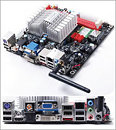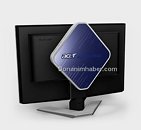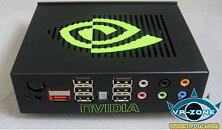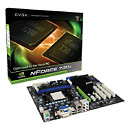
Zotac Readies NVIDIA Ion Mini-ITX Motherboards
After several technical hurdles and some controversy with Intel, NVIDIA was able to go ahead with its Ion platform initiative, where partners are allowed to use Intel Atom processors (both single and dual-core variants) with NVIDIA MCP79-class chipsets. The most distinct feature on offer is the powerful integrated GPU in the form of GeForce 9400M. NVIDIA partner Zotac is ready with two ULPC-friendly mini-ITX motherboards based on the platform, that promise features filled to their brims.
The Zotac IONITX-A-U and IONITX-B-E are powered by Intel Atom 330 dual-core or Atom N230 single-core processors respectively. The only other difference is that the former features an onboard DC-DC power supply. Both feature NVIDIA MCP79 chipset with onboard GeForce 9400M graphics, that comes with clock speeds of 450/1100 MHz (core/shader). Two 240-pin standard DDR2 DIMM slots support DDR2-667/800 MHz memory. There are three SATA II ports provided on the board, with the fourth one placed as an eSATA connector. RAID 0/1 modes are supported. Display outputs are taken care of by D-Sub, DVI and HDMI connectors. The 8-channel audio also provides co-axial and optical SPDIF connections. Six USB 2.0 ports on the back, four through headers, a gigabit Ethernet and WiFi make for the rest of the concoction. It is indicated that the two will hit Japanese stores at prices of JPY 29980 (US$303) for the IONITX-A-U and JPY 19980 ($202) for the IONITX-B-E.
The Zotac IONITX-A-U and IONITX-B-E are powered by Intel Atom 330 dual-core or Atom N230 single-core processors respectively. The only other difference is that the former features an onboard DC-DC power supply. Both feature NVIDIA MCP79 chipset with onboard GeForce 9400M graphics, that comes with clock speeds of 450/1100 MHz (core/shader). Two 240-pin standard DDR2 DIMM slots support DDR2-667/800 MHz memory. There are three SATA II ports provided on the board, with the fourth one placed as an eSATA connector. RAID 0/1 modes are supported. Display outputs are taken care of by D-Sub, DVI and HDMI connectors. The 8-channel audio also provides co-axial and optical SPDIF connections. Six USB 2.0 ports on the back, four through headers, a gigabit Ethernet and WiFi make for the rest of the concoction. It is indicated that the two will hit Japanese stores at prices of JPY 29980 (US$303) for the IONITX-A-U and JPY 19980 ($202) for the IONITX-B-E.











